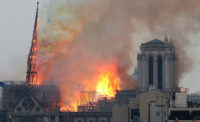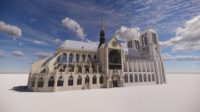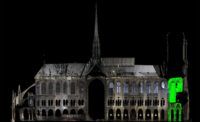Huge oak beams more than 1,000 years old were incinerated in the April 15 fire that consumed the 100-meter-long roof of Notre Dame Cathedral in Paris and toppled its iconic spire. The investigation’s early stage suggests that an electrical fault is among possible causes. Already plans are afoot to rebuild the landmark structure that began life 856 years ago.
Within days of the fire, French Prime Minister Édouard Philippe announced proposed legislation to enable reconstruction to begin and launched an international design competition for the 19th-century spire, which stood some 90 m above ground. Financial pledges quickly topped €1 billion, even before any serious reconstruction cost estimates had been made.
Julien Le Bras, CEO of Le Bras Frères, the 180-person family firm that was handling contracts, denied responsibility for the blaze. “From the start of the fire, absolutely none of the workers from my company were present on the site,” he stated on French TV while appearing visibly distressed.
The company’s affiliate Europe Echafaudage was responsible for erecting the forest of scaffolding on the cathedral roof around the base of the spire. “We want more than anyone else to shed light on [the cause of] this tragedy,” said Le Bras. It would take more than a spark to ignite tree-size oak beams that had matured for centuries, he suggested.
As international architects wait to see specifications of the government’s design competition, a debate on whether to replicate the original spire or go for something new has erupted. At the same time, contractors are gearing up for the reconstruction effort.
Vinci Group promptly urged the whole French construction industry to mobilize, possibly under the auspices of the national Heritage Foundation. Bouygues Construction offered support within the “framework of a skills patronage program.”
Completed around 1240, Notre Dame’s roof was 13 m wide across the nave (the building’s main space) and 40 m over the transept crossing it, over which the spire stood. Framed with large oak girders from trees dating from the 8th century, the roof rose 10 m, with steeply sloping sides covered with lead sheeting.
Beneath the timber roof, limestone vaults cover the internal space. Transverse and diagonal stonework ribs over the nave and transept support secondary vaults to form the limestone ceiling, visible from below.
The destroyed spire was erected as part of a major renovation completed in 1864. The stonework spire replaced an original bell tower destroyed during the French revolution in the late 18th century, after which the cathedral was neglected for years.
Fire Impacts
The fire consumed all of the roof, where it started, according to government officials, and dropped heavy debris and an estimated 200 tonnes of molten lead onto the stonework vault, collapsing it in places. The spire toppled and disappeared into the transept beneath. But efforts of hundreds of firefighters battling for nine hours to quell the flames averted more extensive damage.
Their work to stop flames from reaching the timber supports in the north bell tower saved the cathedral’s west elevation, according to Ministry of Culture fire safety adviser José Vaz de Matos. “If the fire had reached this structure, the tower would have been lost,” he told French TV news.
Acknowledging the vulnerability of the continent’s historic buildings, the French government will convene a meeting of relevant ministers from around Europe on May 3. Led by Secretary of State for European Affairs Amélie de Montchalin and Minister of Culture Franck Riester, the meeting will discuss a potential pooling of resources, for example by establishing a network of experts available in moments of need.
Having seen news footage of the disaster, U.K. master stonemason John David believes reconstruction of Notre Dame will take 10 years. He was on site for the 1984 fire that destroyed part of the lead-covered oak roof of the U.K.’s York Minster, a contemporary of Notre Dame. “We were able to contain the fire by collapsing (part of) the roof onto the floor,” recalls David, now in charge of the Minster’s stonework.
But French President Emmanuel Macron is in a hurry and wants Notre Dame restored in just five years. To achieve that pace, crews will have to apply modern techniques to the building’s ancient materials (see sidebar).






Post a comment to this article
Report Abusive Comment